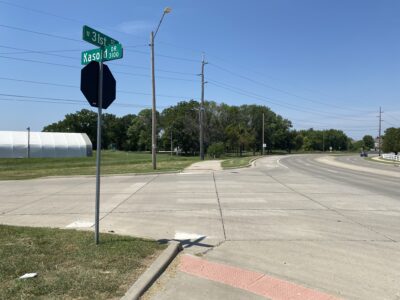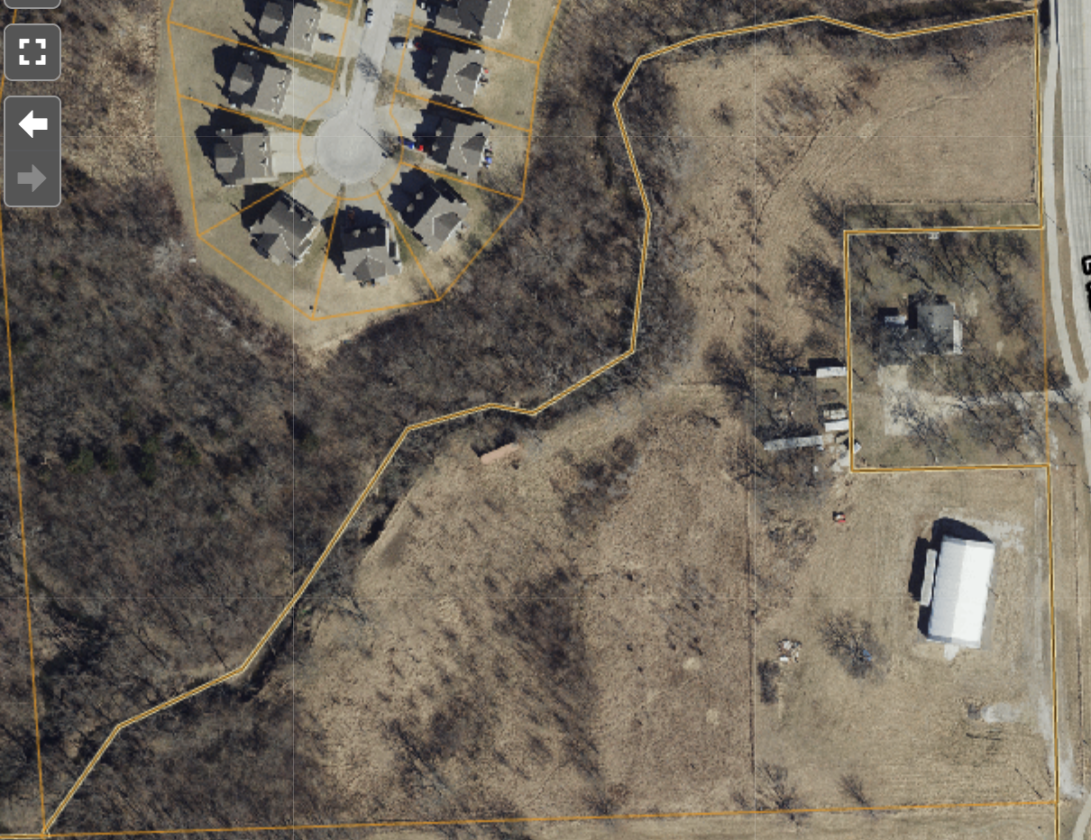Habitat for Humanity aiming to leverage ARPA funds for ‘first of its kind’ neighborhood in west Lawrence

photo by: Austin Hornbostel/Journal-World
Lawrence Habitat for Humanity plans to use American Rescue Plan Act funding to purchase 10 acres of land at 3033 Kasold Drive, which it will eventually turn into the economically-diverse "Kasold Curve Neighborhood." The area of Kasold Drive near that property is pictured here Monday, Aug. 15, 2022.
Lawrence Habitat for Humanity was one of a number of housing agencies selected to receive a portion of Douglas County’s American Rescue Plan Act pandemic aid money last month, and it plans to use its share to kickstart what the agency calls a “first of its kind” project in Lawrence.
County leaders ultimately granted the homebuilding nonprofit $850,000 during the ARPA allocation process in July, which Habitat for Humanity plans to use to purchase 10 acres of land at 3033 Kasold Drive in west Lawrence. Eventually, that land will be developed into an economically-diverse community the agency is calling the “Kasold Curve Neighborhood.”
“Our goal is for people that make all kinds of money at all different levels to live together, so it’s not all low-income housing,” the agency’s executive director, Erika Zimmerman, told the Journal-World Monday.
Coincidentally, the patriarch of the family that owns the land is a long-time Habitat for Humanity supporter and volunteer, Zimmerman said, which makes for a meaningful connection. Six of the 10 acres are what Zimmerman referred to as “buildable,” or suitable for development and construction. The four acres that aren’t buildable are toward the back of the parcel of land, located farther from the roadway.

photo by: Screenshot of Douglas County property viewer
An arial view of the parcel of land Habitat for Humanity plans to purchase off Kasold Drive is pictured here.
Zimmerman said the neighborhood will be comprised of many different types of housing. That could include anything from apartments and townhomes to housing for multiple families and senior cottages.
“It really is, from top to bottom, our goal for this project to build a community that looks different, that feels different from anything that Lawrence has done,” Zimmerman said. “At the end of the day, we just want to provide more housing units.”
The idea is to serve a “spectrum” of housing needs, Zimmerman said, and that would partially be accomplished by including supportive housing units for households with at least one family member with a disability. The application Habitat for Humanity submitted to the county describes a number of ways such assistance could come into play — some units would include around-the-clock supports for people who would not be able to maintain housing without assistance, while others might provide more minimal supports.
Another housing agency, Tenants to Homeowners, also received ARPA funding that will go toward a similar goal of developing housing with supportive services built in. It makes sense, then, that the two agencies are partnering for Habitat for Humanity’s project. Zimmerman said Tenants to Homeowners is even jointly on the contract to purchase the land.
Along with aiming for including those supportive housing elements, Zimmerman said Habitat for Humanity also wants the project to prioritize access. She said bus routes and other elements of transportation access were important considerations when deciding where to look at acquiring land.
Zimmerman said the the current plan is to incorporate some office space for local social service agencies whose main offices are across town in another effort to improve access for the people who will live there. There’s nothing set in stone yet, but she noted agencies like Just Food potentially having a presence on the opposite side of town from their east Lawrence food pantry as good candidates for partners.
“It’s exciting for Habitat, just because we haven’t built on the west side of town before,” Zimmerman said. “To get the opportunity to do that, we’re really, really excited about.”
On top of the location being new for the agency, the scale of the development is, too. Zimmerman said Habitat for Humanity development is usually limited to two or three houses per year, so thinking beyond that is a new challenge.
Arriving at the idea in the first place was the product of plenty of collaboration, she said, but also simply of dreaming big in the pursuit of not just building homes but building communities.
“We got to just sit down and kind of dream,” Zimmerman said. “Like if we had all the money in the world, or if money wasn’t a barrier, what would we want to do? What would we want housing to look like in our community? It was a bunch of people sitting around a table dreaming about what’s possible, and this came out of it.”
After being granted ARPA funding, Zimmerman said the next step will be to complete the land acquisition, which she said hopefully is done by the end of 2022. Following that, there’s much more to do — the need to track down upwards of $3 million to fund construction, for one.
“It’ll come from individual support, it’ll come from federal support, it’ll come from state support, it’ll come from foundations and grants and all the things that we can think of to help support this project,” Zimmerman said. “All those places, and then some I don’t know quite yet. …It’s definitely a puzzle.”
Preparing for development to begin in the first place is also on the to-do list. That’ll involve surveying the land and plotting out where every element will go, and Zimmerman said she wouldn’t be surprised if it also involves something like a traffic study to determine a good spot on Kasold from which to access the neighborhood.
All in all, Zimmerman said she expects it’ll take at least three years before all the work is done, likely in phases based on the type of home under construction. As for the land that won’t be able to support construction, she said she hopes to give the community that eventually will live in the neighborhood a say in the conversation of how it’s used. Zimmerman offered up at least one possible idea — urban agriculture, perhaps by offering apartment residents the use of a small plot of land in a community garden.
“I think we definitely want to utilize that land, and I think we’re going to lean hard on that community that lives there to help us figure out what that looks like,” Zimmerman said. “And even the community (that surrounds the neighborhood) as a whole — what do they want it to look like?”







